1. Introduction
Bilateral platforms, based on bilateral transactions in economic communities and ultra-high-speed coverage of external networks, are gradually becoming the main form of streaming media platforms in online markets. The purpose of this paper is to provide an information base for targeted advertising by analyzing the acceptance level of users in mainland China related to different display methods and different content types of advertisements on streaming video platforms, and to maximize the profit of enterprises by placing advertisements in video platforms. Driven by the gradual enrichment of film and TV content and the protection of legal content rights, more and more users choose to play videos on some well-known video platforms. Video platforms have become one of the most important sources of efficient and profitable information for most large advertising providers in China's modern online society. Advertising has become an indispensable channel for most enterprises to obtain information by communicating between production and consumption, and distribution and consumption through information dissemination. Large enterprises, well-known brands or niche and new brand parties can often increase the exposure rate of the products they sell and stimulate the potential purchase desire of the relevant audience by placing a large number of targeted advertisements through video platforms, thus increasing the success rate of consumers in purchasing the products and achieving a positive communication between the two markets. In addition, video platforms conduct membership through cooperation with advertisers, thus increasing platform revenue and achieving win-win cooperation. This paper will explore the accuracy of data collection and the correlation between different factors through statistical and quantitative analysis. Targeted advertising is based on consumers' personalized information, thus achieving precise delivery. In the past three years, the number of literature on targeted advertising is relatively small. There are only 21 reviews of targeted advertising on CNKI and 80 reviews of targeted advertising on Web of science.
In summary, users' willingness to advertise has become a certain focus in domestic and international research, mainly through linear regression models for hypothesis validation and exploring the factors that influence users' acceptance. For enterprises, the placement of personalized advertisements for specific groups of people on video platforms is little known. In this paper, we will explore the influence on the form, type and content of the appearance of advertisements in terms of three factors: age, gender and occupation. It will provide an effective marketing basis for targeted advertising on video platforms.
2. Literature Review
2.1. Definition of Research Subjects
Advertising is an important channel that companies use to promote their products. With the popularity and sophistication of the Internet, it has become increasingly common for companies to use social media for online marketing, such as heavy placement on social software and video platforms, in order to increase product awareness. The development of the Internet has led to the emergence and development of the concept of "targeted advertising," which is an extension of ad placement. Targeted advertising is a way for Internet service providers to collect and organize user information using online tracking technology, storing user information according to categories such as age, gender, occupation, and hobbies. Then, online ad delivery technology is used to send ads with different contents to different categories of users. Dutch scholar Sophie C. Polman defines targeted advertising as the practice of monitoring people's online behavior and using the information collected to show people personalized advertisements. A study by the Network Advertising Initiative in 2009 measured the effectiveness of pricing and targeted advertising. It revealed that targeted ads: i. Generate an average of 2.7 times more revenue per ad compared to non-targeted "web placement" ads. ii. Second, it is twice as effective at converting users who click on an ad into buyers [1]. Most of the literature on the topic of "targeted advertising" in mainland China as well as globally analyzes and classifies the perceived ability of users; a few other literatures have studied user stickiness and relevant channels of information acquisition to improve the accuracy of targeted advertising. In recent years, with the popularity of short videos, there are relevant papers on ad insertion in short videos. However, there is little literature on the topic of targeted advertising on large video platforms, especially on how to target users' characteristics and preferences to accurately deliver ads on video platforms to achieve greater revenue. The high speed and flexibility of bilateral market resources are achieved through video platforms.
2.2. Research Methods
With the rapid development of new media technology, the strategy of advertising has gradually stabilized. Due to the exponential growth in the number of Internet users, more and more companies are choosing to advertise on streaming media platforms. Streaming media platforms and ad placements can somehow achieve a coexistence of interests. The placement of ads increases the market share for the platform itself; and for the membership, the video platform gains revenue from the user market. The two are interdependent. Jamieson, Campbell said in The interplay of influence that the wider the reach of the media, the more people will be exposed to the ads and the greater the influence, the more effective the ads will be [2]. However, the higher the reach, the better. Since user group categories have different behavioral characteristics, the advertising for users needs to be precise and personalized. The strategy of targeting ads is extremely important.
Internet advertising has always been one of the ways for enterprises to increase the exposure of their products, and among the various forms of advertising and marketing, the advertising revenue placed on in-stream advertising gradually accounts for an increasing proportion of the total profit gained from advertising with the development of the Internet. The survey results show that the growth rate of China's Internet advertising market size will be about 8.55% from 2021 to 2027. By 2027, the market size of China's Internet advertising industry will be close to 900 billion yuan. The transformation and pursuit of refinement, efficiency and digital intelligence of marketing by enterprises or brands is the direction of joint efforts of all parties in the industry chain of the online advertising market, and is also the core driver of the sustainable growth of the online advertising market in the future [3].
As the size of Internet users expands year by year, research on targeted advertising strategies is gradually increasing. Rafieianetal empirically and experimentally demonstrated that targeted advertising can increase click-through rates, and Iyeretal showed that through targeted advertising, companies can eliminate wasteful advertising and generate higher profits by targeting consumers whose preferences do not match their product attributes. A company's targeted advertising strategy needs to be matched with user data information for accurate marketing through statistical data. The key to accurate marketing lies in the collection and analysis of user data. In this regard, a literature study predicts user engagement rate, extracts important attributes of posts, and introduces an adaptive hybrid convolutional model based on FW-CNN-LSTM. FCM and XGBoost algorithms are used to cluster the selected data based on the weights and salience of the attributes, and then CNN-based and lstm-based methods are applied to select similar features [4]. Thus, the accuracy of the data is improved and the exact characteristics of the users are analyzed to deliver targeted advertisements.
3. Data Collection Process and Data Description
At present, video platform is one of the important platforms for Chinese Internet users to conduct online activities and one of the important carriers for enterprises or advertisers to place advertisements. This study is set in the context of typical video platforms in mainland China (Tencent Video, Akiyip Video, etc.), and collects the acceptance level of some users from mainland China for the advertisements appearing on video platforms as well as gets some respondents' suggestions for the advertisements. A total of 216 questionnaires were collected in this survey, of which 138 were valid. It is mainly divided into four parts: first, the tolerance level of the population towards ads; second, the acceptance level of different people towards different forms of appearance or placement of ads; third, the preference level of different people towards different types of ads; fourth, the preference level of different people towards different ad contents. Finally, relevant conclusions are drawn through statistics to achieve a benign structure for enterprises by placing targeted advertisements on video platforms in order to improve market share and increase corporate profits for bilateral platforms.
The most oriented as well as targeted marketing strategy of targeted advertising is the basic information characteristics of users. The three most important basic characteristics collected in this study are - age, gender and occupation. The subjects were collected from four age groups, namely men and women younger than 18, 18-23, 24-35, and older than 35. And mainly from nine occupational categories. In response, drawing descriptive statistical charts for a more visual analysis of the findings. The collected data were also analyzed and the data were relatively reliable. This study first analyzed the average value of users' acceptance of advertisements is about 31.52%, as shown in Table 1. The analysis shows that for the overall population, there is not a high tolerance for ads in video platforms. We will analyze the attitudes of different groups of people regarding different forms of appearance, different types and different contents of advertisements.
Table 1: Average tolerance level [Owner-draw].
N | Mininum | Maximum | Mean | Std. Deviation | |
Advertising acceptance | 138 | 0.00% | 100.00% | 31.5217% | 24.24155% |
Valid N (listwise) | 138 |
4. Users Acceptance Reagarding Different Forms of Advertising Appearance
For advertisers (companies), how to increase the market share of their ads is the key to get the most profit. The way ads appear on video platforms is the key to getting more users to see product ads. Ads can be placed precisely in different ways depending on the user's acceptance of the ad. Depending on the way the ads appear, the users' acceptance level varies. In this report, five major forms of ad appearances were selected for analysis - I. Pop-up window on pause; II. Opening Screen / Pop-up; III. Browse the corner pop-ups in the page; IV. Before the video plays; V. Scrolling push on the home page. As shown in Figure 1, after data collection, none of the surveyed users fully accepted the interstitial ads before the video content was played.
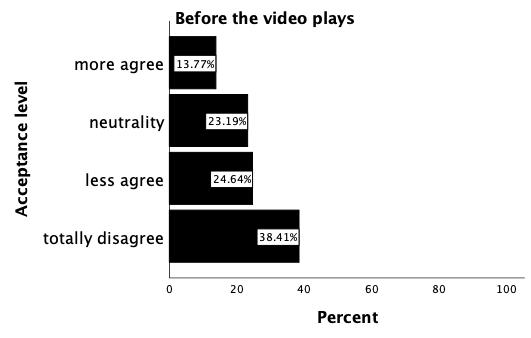
Figure 1: Acceptance of ads before the video is played [Owner-draw].
At the same time, among the five types of ad appearances, we conducted statistics on the Pop-up window on pause and Scrolling push on the home page as shown in Figure 2, and found that more users said they totally agree with, more agree with, and are neutral than other ad appearances. For this reason, advertisers can make use of these method for advertising. It is recommended that companies can push rolling ads on the home page of the video platform, which should not be too long, and select the most significant advantages of the product for placement. As well as in the video pause can be advertising, the ad can often be placed according to the length of the user pause, improve advertising for the actual situation of the user, as complete as possible or choose the more attractive part to put.
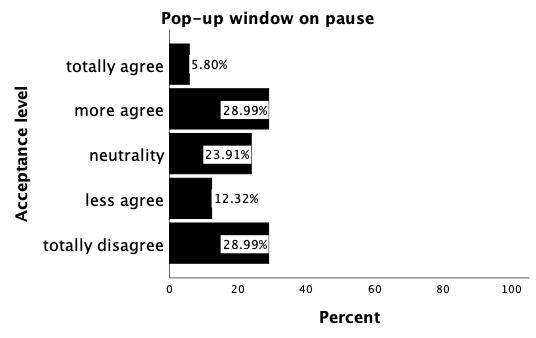
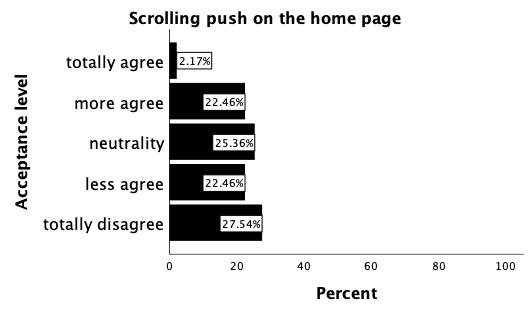
Figure 2: Acceptance of ads of pop-up window on pause and scrolling push on the home page [Owner-draw].
5. User Preferences for Different Advertisement Types
This study classifies the current types of advertising into eight main categories, namely Games, Food, Daily chemical products, Electronic products category, Mobility tools category, Apparel, Household We conducted statistics on these eight types of advertisements, as shown in Figure 3, and concluded that users prefer advertisements about food, which accounts for the largest proportion, and advertisements about Household The respondents were not very interested in the advertisements about Mobility tools and Application software (APP) or website promotion category, which accounted for the lowest percentage.
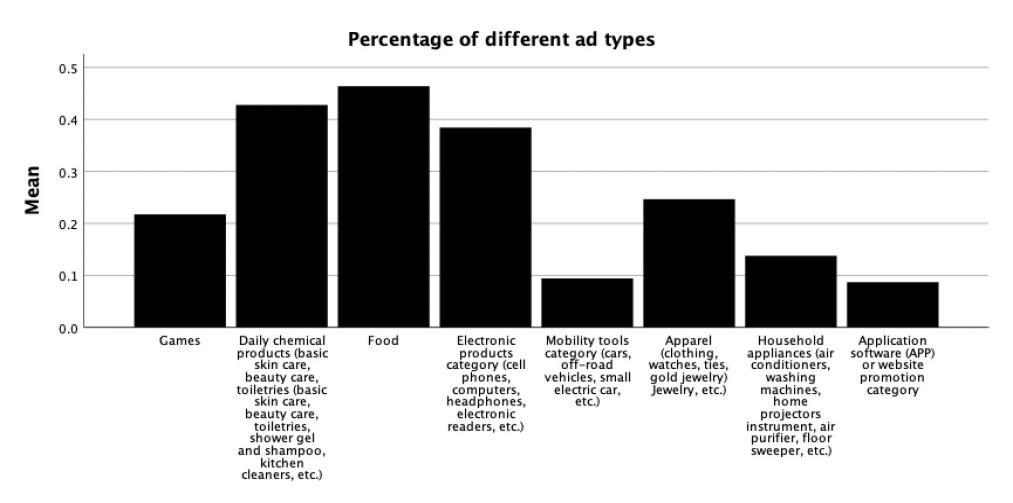
Figure 3: Average user acceptance of different AD types [Owner-draw].
The level of perception of the masses will vary for different types of advertisements. The psychological concept of audience revulsion needs to be addressed here. The limitation of ad types has led some advertisers to place too many types of ads. And audience revolt psychology refers to the psychological tendency of resistance and rebellion held by the audience against the excessive dissemination of information with the same content and monotonous form. Due to the rapid development of the Internet, new APPs or websites keep emerging, but the differences in the accumulation of original capital lead to the placement of ads with too much identical content, so they are too monotonous and lack of diversity for the audience. On the contrary, due to the wide variety of food products and the fact that food is the basic material for basic human activities, and food is very well understood and indispensable in people's life. Therefore, even if consumers do not want to buy food in video advertisements, they can increase their understanding of food and keep up with the trend. At the very least, consumers will not hate food, and most of them will like to watch food advertisements, such as chocolate and ice cream advertisements in the dream design, which can increase the happiness index of consumers, so they will not dislike food advertisements [5]. As a company or an advertising distributor, among which food companies should expand the range of food placement categories. According to Figure 3, basic products closely related to life, such as daily bathroom products and electronic products, account for a relatively high proportion of advertisements.
5.1. Effect of Age on Preference of Advertisement Type
As shown in Figure 4, it can be concluded that, i. between the age of 18-23, the proportion of the group choosing food, daily chemical products and electronic products is higher; ii. between the age of 24-35, the proportion of the group choosing daily chemical products and electronic products is higher; iii. older than 35, food ads account for the highest overall. (The relevant findings were not counted for people under the age of 18 because the sample data on this topic were too small for people under the age of 18.)
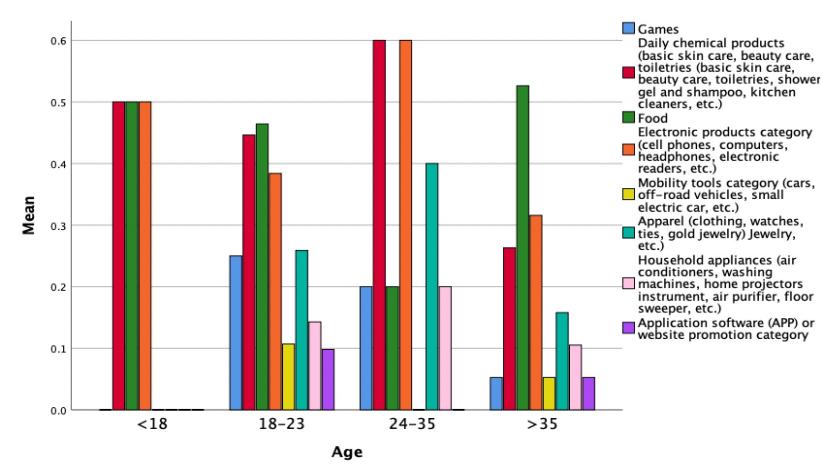
Figure 4: The percentage of different age groups about type [Owner-draw].
According to the statistical chart, it can be seen that for people between 18-23 years old, the least attention is paid to transportation, such as family cars, in line with the current situation of this age group, as this age group is in the undergraduate or graduate stage and has less assets. For people aged 24-35, most of them are already working or married at that stage, so they are more interested in advertisements about daily life. People older than 35 years old are characterized by having a family or a stable job, so they pay the most attention to food advertising, which is an important survival resource.
5.2. Gender Affects Advertisement Type Preference
By drawing bar charts, there are obvious differences in the choice of advertisement types by gender. Figure 5 shows that men have obvious interest preference for electronic products ads; while women mainly favor daily necessities and food ads. The statistical chart shows that men are more interested in electronic products and games, which are more professional types of advertisements; women choose more types of advertisements about daily life and food, clothing, housing and transportation, which are related to the basis of life. For example, lipstick, girls will immediately place an order when they see a beautiful color in an advertisement. Even if they do not place an order, they will also like watching videos of cosmetics [6]. Different genders are typical for different fields of advertising, which is consistent with common sense. However, according to the statistical chart, the population is not interested in the ads of transportation and software types such as cars, which is contrary to the common.
.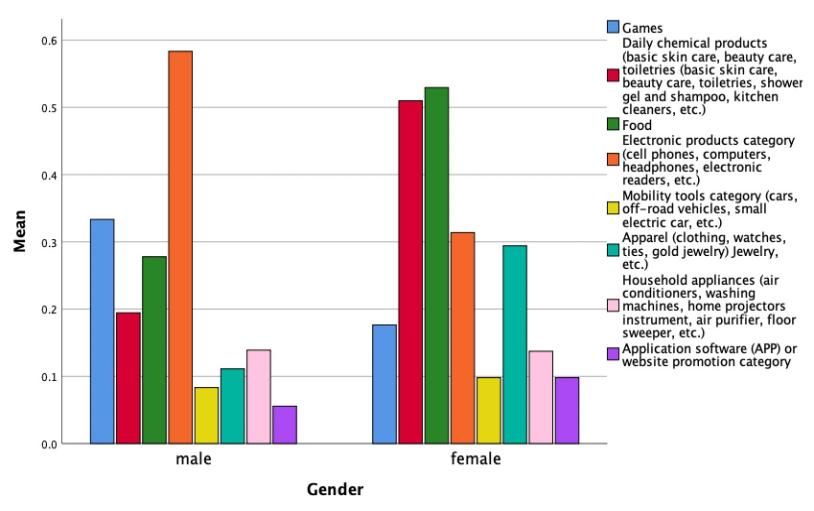
Figure 5: The percentage of different gender groups about type [Owner-draw].
5.3. Occupation for the Choice of Advertising Type
According to Figure 6, because of the paucity of data obtained for the remaining five population categories and the lack of significant differences, only four categories of students, workers, service workers, and company employees were analyzed in this study. students prefer food ads, daily necessities and electronic products; workers pay more attention to electronic products; service industry workers pay more attention to food and daily necessities; and company employees pay more attention to food.
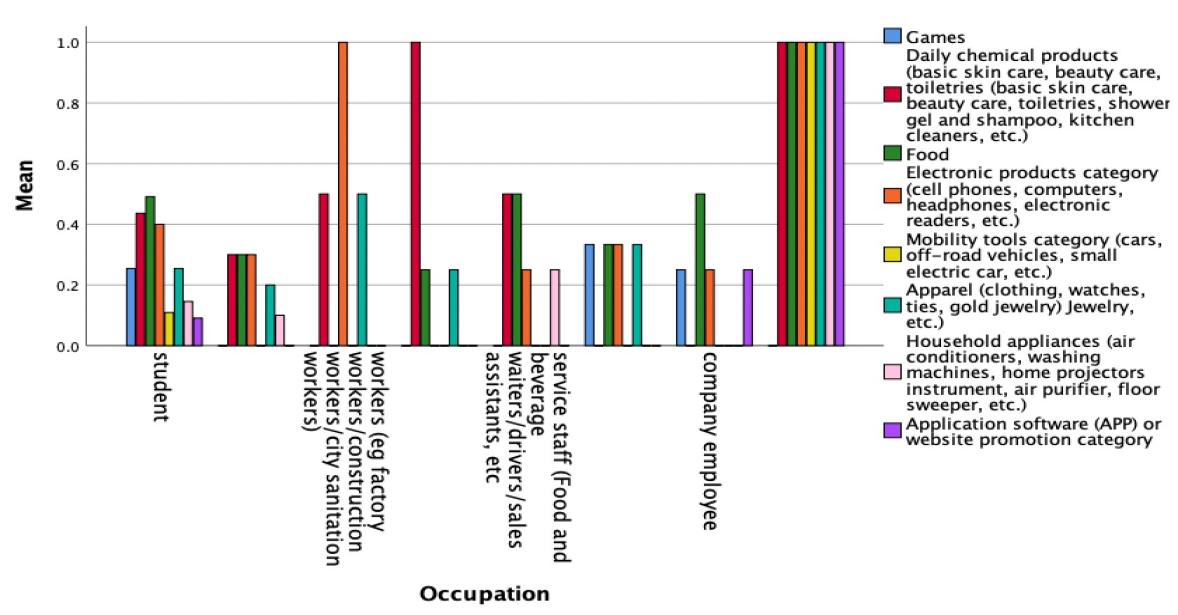
Figure 6: The percentage of different occupation groups about type [Owner-draw].
For the four sets of data obtained, it was found that a higher percentage of company employees were concerned about food-based advertisements, which is contrary to common sense in life. In response, the analysis is as follows: 1) the sample data is too small, so it is not typical; 2) due to the increased pressure of life, company employees are more concerned about the types of products that can meet their material needs and are more basic. In view of this, advertisers or enterprises should consciously improve the placement of food advertisements.
6. Degree of Selection of Advertising Content
Users have different levels of acceptance for different advertising content. In this study, we selected eight different types of content and briefly described and analyzed them. The analysis obtained 127 valid results as shown in Figure 7, the largest proportion of users who chose the content of the ad as a story, followed by public service type ads; and the least proportion of celebrity endorsement ads and ads with fictional content.
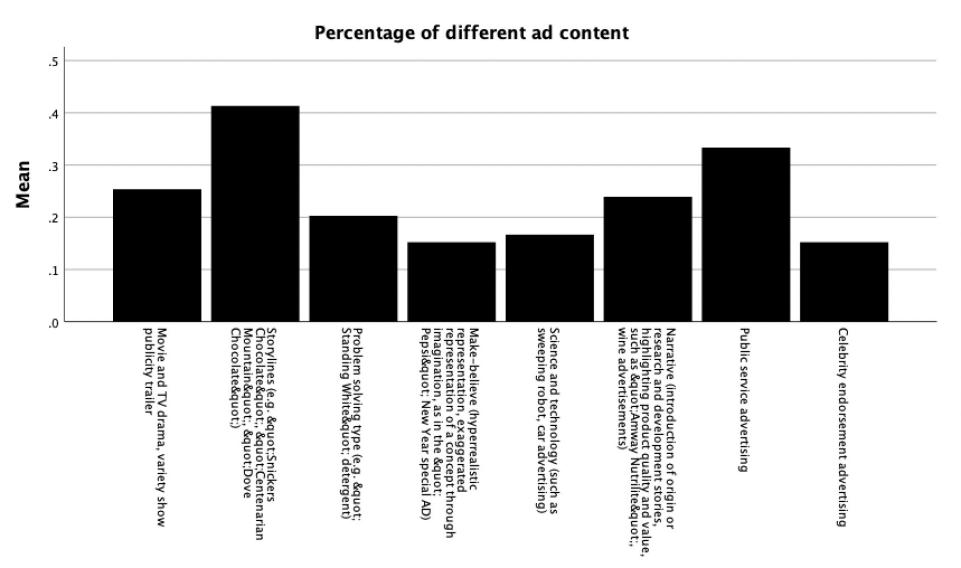
Figure 7: Average user acceptance of different AD types [Owner-draw].
In response to the low percentage of celebrity endorsement ads, the audience crisis may be triggered by information asymmetry or even false advertising. Mowen and Brown (1951) illustrate that when consumers are informed that a celebrity endorses multiple products, consumers' perceptions of the reliability of that celebrity diminish, as well as their perceptions of the credibility of the brands and advertisements they endorse. And Basil believes that audience attitudes and behavioral changes may be influenced by the target audience's perception of the endorser's identity [7]. Therefore, investors should determine the effectiveness of the positive influence of well-known figures and should be cautious about using celebrity endorsements to expand their visibility.
6.1. Factors Affecting the Choice of Advertising Content
According to Figure 8, i. users are aged 18-23, with the main content bias being story-drama and public service announcements; ii. users are aged 24-35, with the main bias being problem-solving and story-drama; iii. people aged 35 and above are mainly biased towards public service announcements. (The data of user groups under 18 years old are too few to be effectively analyzed.)
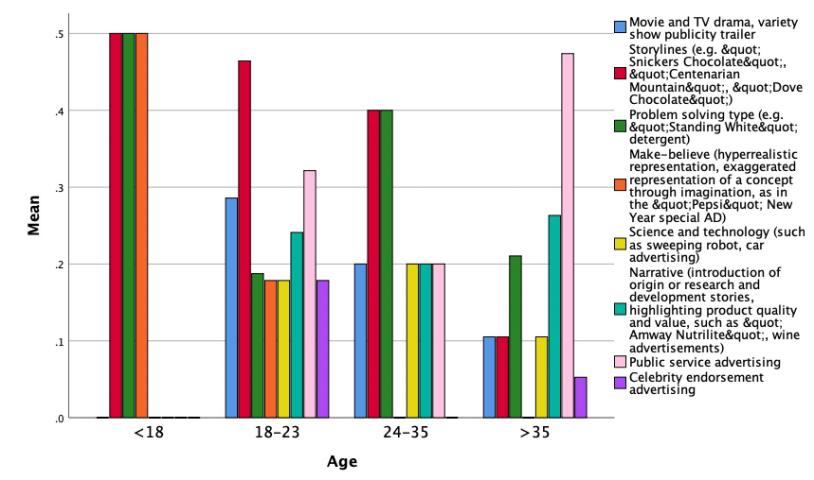
Figure 8: The percentage of different gender groups regarding the content [Owner-draw].
There are obvious differences and characteristics of gender on the selection of advertising content. As shown in Figure 9, women are more interested in story-drama type ad content, accounting for the largest proportion, while they are not too interested in technology type content, accounting for the lowest proportion; men are more biased toward technology and utility type ad content, but not interested in ad content that is biased toward entertainment. The conclusion is in line with the personality characteristics of men and women and is typical.

Figure 9: The percentage of different gender groups regarding the content [Owner-draw].
6.2. Public Service Advertising and Business Marketing
According to the three statistical charts above, the crowd has the strongest preference for public service ads (PSA). And for platforms and advertising investors, the placement of PSAs actually has a certain degree of exclusivity, which will greatly reduce the share of capital. So how should we treat the placement of PSAs correctly? Public Service Advertising is separated from advertising and dedicated to the specific function of "public service" [8]. In his Introduction to Public Service Advertising, Pan Zehong emphasizes: not to create an image of goods and not to aim at profit. It also requires that the advertiser appearing in it must be a non-profit organization. However, the social marketing concept of Philip Kotler and others believes that marketing is a solution that uses commercial marketing tools to achieve social good purposes, or uses the value of social good to promote commercial services. Not only can the PSA business borrow the theoretical tools of marketing in the commercial field, but also enterprises can use the value of public welfare to promote their corporate image and sales of their products in order to promote the healthy communication between enterprises and PSAs [8].
7. Conclusion
The following suggestions were drawn after this study. First, advertisers (enterprises) should pay attention to the airtime and platforms of popular dramas or variety shows, and focus on those with high pre-hotness. And combine membership with advertising. Data shows that most users cannot accept the ads inserted before the video, so they can target this for advertising and and cooperate with third-party platforms. Second, food companies can try to put as much as possible, advertisers can cooperate with related companies to put. Enterprises should be particularly gender-specific differences in placement, for male users can increase the rate of electronic products, while for female users are more involved in life class advertising, increasing the market exposure of products. Third, advertisers can cooperate with social groups or the government for the placement of PSAs. For example, "After the Wave", which has won many awards, is an advertisement released by the website bilibili on May 3, 2020 (the eve of May 4 Youth Day). Statistics show that it has received 25,620,000 views, 273,000 bullet screens, 1,569,000 likes and 1,0209,000 retweets on the network platform [9]. As well, since story ads are relatively new and have a plot, they can easily stimulate the interest of users, so they can be more innovative in the content of story ads. For celebrity endorsement ads, enterprises or advertisers need to be cautious. Data shows that most of them are not interested in celebrity endorsement ads, which may be caused by information inequality or bad artists' endorsement. Jin Kaida and Liu Shujuan argued in the article Brief Analysis of the Role and Risk of star advertising endorsement [10] that the role and risk coexist with star advertising endorsement. So for companies or advertisers how they can increase market exposure through video platform placement is a question that most companies need to think about on an ongoing basis.
References
[1]. Han Hao. (2021) A study on the influence of retargeting advertising attitude from the perspective of user perception. NEW MEDIA RESEARCH. 2096-0360(2021)08-0048-05: 48-52.
[2]. Xingchen Yang. (2021) Research on Internet-based new media advertising strategy. SHENG PING SHIJIE. 2021/10 Next: 81-83.
[3]. (2022) 2022-2027 Annual Research and Consultation Report of Panorama survey and Investment strategy on China Industry. CIRN. Beijing.
[4]. S.Mohsen Ebadi Jokandan,P.Bayat,M.Farrokhbakht Foumani. (2022) Targeted Advertising in Social Media Platforms Using Hybrid Convolutional Learning Method besides Efficient Feature Weights. Hindawi Journal of Electrical and Computer Engineering. Article ID 6159650,17 pages.
[5]. Yachu Zhao,Lijuan Qiao. (2019) The Influence of food product Placement on Young Consumers' Willingness to Consume: A Case study of college students in Hangzhou. Modern Marketing (Management). No. 323 (11): 115-116.
[6]. Hui Cao. (2019) Study on the influence of consumer preference and purchasing behavior of domestic cosmetics brand. Yunnan University of Finance and Economics. DOI: 10.27455 /, dc nki. Gycmc. 2019.000071.
[7]. Zongjin Yang. (2011) Celebrity advertising endorsement crisis. SHANGYE JINGJI. 1009- 6043(2011)3- 0018- 03: 18-20.
[8]. Xiaohong Yang. (2022) The Exclusive Property of Public Service Advertising and the Public Service Communication of Advertising. Journalism&Communication Review. Vol. 75 No. 4 Jul. 2022. 087-095.: 87-95.
[9]. Jialai Fan, (2020). The team behind "Afterwave" said it wasn't just a story for young people.https://www.thepaper.cn /newsDetail_forward_7268436.
[10]. Kaida Jin, Shujuan Liu. (2019) Analysis on the role and Risk of star advertising endorsement[J]. Public Literature and Art, 2018 (02) : 170.
Cite this article
Zhu,Z.;Zhao,X. (2023). Targeted Advertising Placement in Video Platforms: Implications for Business Profitability. Advances in Economics, Management and Political Sciences,21,66-77.
Data availability
The datasets used and/or analyzed during the current study will be available from the authors upon reasonable request.
Disclaimer/Publisher's Note
The statements, opinions and data contained in all publications are solely those of the individual author(s) and contributor(s) and not of EWA Publishing and/or the editor(s). EWA Publishing and/or the editor(s) disclaim responsibility for any injury to people or property resulting from any ideas, methods, instructions or products referred to in the content.
About volume
Volume title: Proceedings of the 2023 International Conference on Management Research and Economic Development
© 2024 by the author(s). Licensee EWA Publishing, Oxford, UK. This article is an open access article distributed under the terms and
conditions of the Creative Commons Attribution (CC BY) license. Authors who
publish this series agree to the following terms:
1. Authors retain copyright and grant the series right of first publication with the work simultaneously licensed under a Creative Commons
Attribution License that allows others to share the work with an acknowledgment of the work's authorship and initial publication in this
series.
2. Authors are able to enter into separate, additional contractual arrangements for the non-exclusive distribution of the series's published
version of the work (e.g., post it to an institutional repository or publish it in a book), with an acknowledgment of its initial
publication in this series.
3. Authors are permitted and encouraged to post their work online (e.g., in institutional repositories or on their website) prior to and
during the submission process, as it can lead to productive exchanges, as well as earlier and greater citation of published work (See
Open access policy for details).
References
[1]. Han Hao. (2021) A study on the influence of retargeting advertising attitude from the perspective of user perception. NEW MEDIA RESEARCH. 2096-0360(2021)08-0048-05: 48-52.
[2]. Xingchen Yang. (2021) Research on Internet-based new media advertising strategy. SHENG PING SHIJIE. 2021/10 Next: 81-83.
[3]. (2022) 2022-2027 Annual Research and Consultation Report of Panorama survey and Investment strategy on China Industry. CIRN. Beijing.
[4]. S.Mohsen Ebadi Jokandan,P.Bayat,M.Farrokhbakht Foumani. (2022) Targeted Advertising in Social Media Platforms Using Hybrid Convolutional Learning Method besides Efficient Feature Weights. Hindawi Journal of Electrical and Computer Engineering. Article ID 6159650,17 pages.
[5]. Yachu Zhao,Lijuan Qiao. (2019) The Influence of food product Placement on Young Consumers' Willingness to Consume: A Case study of college students in Hangzhou. Modern Marketing (Management). No. 323 (11): 115-116.
[6]. Hui Cao. (2019) Study on the influence of consumer preference and purchasing behavior of domestic cosmetics brand. Yunnan University of Finance and Economics. DOI: 10.27455 /, dc nki. Gycmc. 2019.000071.
[7]. Zongjin Yang. (2011) Celebrity advertising endorsement crisis. SHANGYE JINGJI. 1009- 6043(2011)3- 0018- 03: 18-20.
[8]. Xiaohong Yang. (2022) The Exclusive Property of Public Service Advertising and the Public Service Communication of Advertising. Journalism&Communication Review. Vol. 75 No. 4 Jul. 2022. 087-095.: 87-95.
[9]. Jialai Fan, (2020). The team behind "Afterwave" said it wasn't just a story for young people.https://www.thepaper.cn /newsDetail_forward_7268436.
[10]. Kaida Jin, Shujuan Liu. (2019) Analysis on the role and Risk of star advertising endorsement[J]. Public Literature and Art, 2018 (02) : 170.









